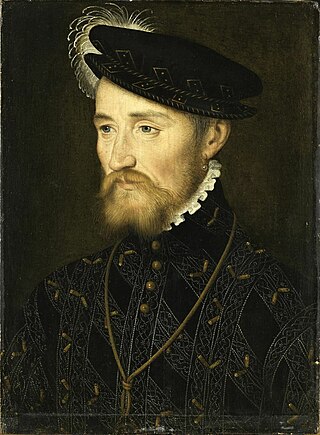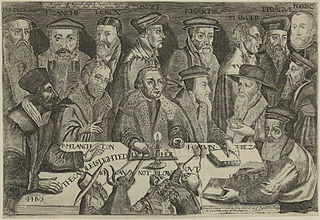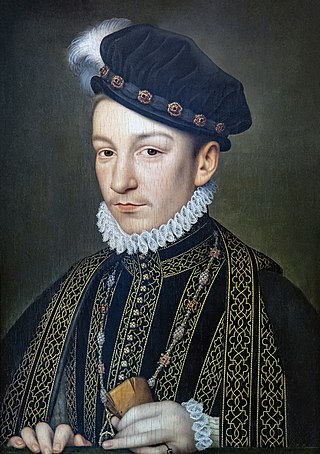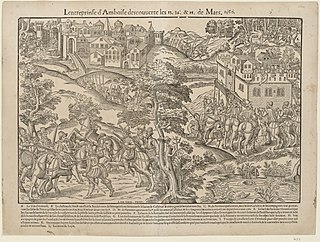
Theodore Beza was a French Calvinist Protestant theologian, reformer and scholar who played an important role in the Protestant Reformation. He was a disciple of John Calvin and lived most of his life in Geneva. Beza succeeded Calvin as the spiritual leader of the Republic of Geneva.

Peter Martyr Vermigli was an Italian-born Reformed theologian. His early work as a reformer in Catholic Italy and his decision to flee for Protestant northern Europe influenced many other Italians to convert and flee as well. In England, he influenced the Edwardian Reformation, including the Eucharistic service of the 1552 Book of Common Prayer. He was considered an authority on the Eucharist among the Reformed churches, and engaged in controversies on the subject by writing treatises. Vermigli's Loci Communes, a compilation of excerpts from his biblical commentaries organised by the topics of systematic theology, became a standard Reformed theological textbook.

The French Wars of Religion were a series of civil wars between French Catholics and Protestants from 1562 to 1598. Between two and four million people died from violence, famine or disease directly caused by the conflict, and it severely damaged the power of the French monarchy. One of its most notorious episodes was the St. Bartholomew's Day massacre in 1572. The fighting ended with a compromise in 1598, when Henry of Navarre, who had converted to Catholicism in 1593, was proclaimed King Henry IV of France and issued the Edict of Nantes, which granted substantial rights and freedoms to the Huguenots. However, Catholics continued to disapprove of Protestants and of Henry, and his assassination in 1610 triggered a fresh round of Huguenot rebellions in the 1620s.

Michel de l'Hôpital was a French lawyer, diplomat and chancellor during the latter Italian Wars and the early French Wars of Religion. The son of a doctor in the service of Constable Bourbon he spent his early life exiled from France at Bourbon's and then the emperors court. When his father entered the service of the House of Lorraine, he entered the patronage network of Charles, Cardinal of Lorraine. Through his marriage to Marie Morin, he acquired a seat in the Paris Parlement. In this capacity he drew up the charges for the king, concerning the defenders of Boulogne who surrendered the city in 1544, before taking a role as a diplomat to the Council of Trent in 1547. The following year he assisted Anne d'Este in the details of her inheritance to ensure she could marry Francis, Duke of Guise.

François de Lorraine, 2nd Duke of Guise, 1st Prince of Joinville, and 1st Duke of Aumale; 17 February 1519 – 24 February 1563), was a French general and statesman. A prominent leader during the Italian War of 1551–1559 and French Wars of Religion, he was assassinated during the siege of Orleans in 1563.
Crypto-Calvinism is a pejorative term describing a segment of those members of the Lutheran Church in Germany who were accused of secretly subscribing to Calvinist doctrine of the Eucharist in the decades immediately after the death of Martin Luther in 1546. It denotes what was seen as a hidden Calvinist belief, i.e., the doctrines of John Calvin, by members of the Lutheran Church. The term crypto-Calvinist in Lutheranism was preceded by terms Zwinglian and Sacramentarian. Also, Jansenism has been accused of crypto-Calvinism by Roman Catholics.

The Edict of Saint-Germain, also known as the Edict of January, was a landmark decree of tolerance promulgated by the regent of France, Catherine de' Medici, in January 1562. The edict provided limited tolerance to the Protestant Huguenots in the Catholic realm, though with counterweighing restrictions on their behaviour. The act represented the culmination of several years of slowly liberalising edicts which had begun with the 1560 Edict of Amboise. After two months the Paris Parlement would be compelled to register it by the rapidly deteriorating situation in the capital. The practical impact of the edict would be highly limited by the subsequent outbreak of the first French Wars of Religion but it would form the foundation for subsequent toleration edicts as the Edict of Nantes of 1598.

Louis de Lorraine, cardinal de Guise et prince-évêque de Metz was a French Roman Catholic cardinal and Bishop during the Italian Wars and French Wars of Religion. The third son of Claude, Duke of Guise and Antoinette de Bourbon he was destined from a young age for a church career. At the age of 18 he was appointed Bishop of Troyes, a position he could only serve in an administrative capacity as he would not reach the Canonical Age for another 9 years. Having served in this position for 5 years, he transferred to become Bishop of Albi, staying in this role until 1561, when he was replaced due to his lethargic suppression of 'heresy'. From here he moved to become Archbishop of Sens, a see he would hold from 1561 to 1562, during which time a massacre of Protestants would occur in the city. By 1562 he decided to retire from active episcopal involvement. Nevertheless, he would become Prince-Bishop of Metz in 1568, an office he would hold until his death a decade later. While he lacked much interest in spiritual matters and was renowned for his drinking, he built up a considerable empire of abbeys during his life, which he passed on to his nephew Claude, chevalier d'Aumale.
Nicolas des Gallars [in Lat. Gallasius], was a Calvinist pastor and theologian.

Reformed Christianity originated with the Reformation in Switzerland when Huldrych Zwingli began preaching what would become the first form of the Reformed doctrine in Zürich in 1519.
Claude de Sainctes was a French Catholic controversialist.

François de Tournon was a French Augustinian friar, an archbishop, diplomat, courtier, and cardinal. From 1536 he was also a military supply officer of French forces operating in Provence, Savoy and Piedmont. In the same year he founded the Collège de Tournon. For a period he was effectively France's foreign minister. He was a prominent leader in the fight against Lutheranism and Calvinism, especially at the French Royal Court, and what he perceived as the growing Huguenot menace to both doctrinal orthodoxy and the social order. He took a prominent role in the Estates General of 1560, the Colloquy of Poissy and the Colloquy of Saint-Germain in 1562. He participated in the papal conclaves of 1534, 1549, and 1559.

Jean de Monluc, c. 1508 to 12 April 1579, was a French nobleman, clergyman, diplomat and courtier. He was the second son of François de Lasseran de Massencome, a member of the Monluc family; and Françoise d' Estillac. His birthplace is unknown, but it has been observed that his parents spent a great deal of time at their favorite residence at Saint-Gemme in the commune of Saint-Puy near Condom. His elder brother Blaise de Montluc became a soldier and eventually Marshal of France (1574).

Protestantism in France has existed in its various forms, starting with Calvinism and Lutheranism since the Protestant Reformation. John Calvin was a Frenchman, as were numerous other Protestant Reformers including William Farel, Pierre Viret and Theodore Beza, who was Calvin's successor in Geneva. Peter Waldo was a merchant from Lyon, who founded a pre-Protestant group, the Waldensians. Martin Bucer was born a German in Alsace, which historically belonged to the Holy Roman Empire, but now belongs to France.
The Altered Augsburg Confession is a later version of the Lutheran Augsburg Confession that includes notable differences with regard to holy communion and the presence of Christ in bread and wine. It is distinguished from the unaltered or Editio princeps.

Jakob Beurlin was a German Lutheran theologian and Protestant Reformer of the Duchy of Württemberg.
Events from the year 1561 in France

The Estates General of 1560–1561 was a national meeting of the three estates of France, the clergy, nobility and commoners convoked by François II, though he would die before it could begin. It represented the first meeting of the estates general in 76 years, the last one having been convened by Charles VIII at Tours. Meeting at Orléans the estates would be tasked with providing solutions to the crowns dire fiscal problems, a legacy of the Habsburg–Valois Wars, and the growing religious problem caused by the Reformation. The estates would however be unable to finish their deliberations, with Catherine de' Medici proroguing the session, and reconvening the estates general at a later date in 1561 at Pontoise, where she sought a more agreeable selection of delegates. Ultimately the work of the estates would solve neither the crowns fiscal insolvency or the religious conflict, which exploded in the first French War of Religion.

The Edict of Saint-Maur was a prohibitive religious edict, promulgated by Charles IX of France at the outbreak of the third war of religion. The edict revoked the tolerance that had been granted to Protestantism, in the edicts of Saint-Germain, Amboise and the peace of Longjumeau. The edict forbade the exercise of any religion other than Catholicism in the kingdom of France, and gave Protestants 15 days to vacate the kingdom. Ultimately the edict would be overturned in the landmark peace of Saint-Germain-en-Laye at the end of the third religious war in 1570 which restored recognition to Protestantism, alongside many other concessions.

The 1559–1562 French political crisis was induced by the death of the king Henri II in July 1559. With his death, the throne fell to François II who though not a minor, lacked the ability to command authority due to his young age. Actual power fell to two of Henri II's favourites, the duc de Guise and cardinal de Lorraine who quickly moved to assert a monopoly of their authority over the administration of the kingdom. Royal patronage would flow to them and their clients, with those of their rival, Constable Montmorency quickly starved of royal favour. Having been left with ruinous debts by Henri, they undertook a campaign of aggressive austerity which further alienated many grandees and soldiers who were not shielded from its effects. They also continued the persecution of Protestantism that had transpired under Henri II, though with the young François on the throne the Protestants felt emboldened to resist.
















